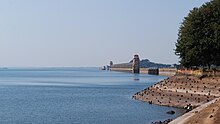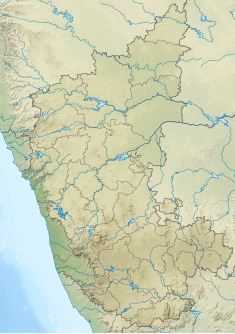
Back سد تونجابهادرا ARZ Tungabhadra Dam CEB Barrage de Tungabhadra French ತುಂಗಭದ್ರಾ ಅಣೆಕಟ್ಟು Kannada ਤੁੰਗਭੱਦਰਾ ਡੈਮ Punjabi Zapora Tungabhadra Polish تنگبھدرا ڈیم PNB துங்கபத்ரா அணை Tamil తుంగభద్ర ఆనకట్ట Tegulu ГЕС Тунґабгадра/Мунірабад Ukrainian
| Tungabhadra Dam | |
|---|---|
 | |
| Official name | Tungabhadra Dam |
| Location | Hospet, Vijayanagara district, Karnataka, Munirabad, Koppal district, Karnataka, India |
| Construction began | 1949 |
| Opening date | 1953 |
| Construction cost | 1,066,342 Dollars |
| Owner(s) | Karnataka State |
| Operator(s) | Tungabhadra Board |
| Dam and spillways | |
| Type of dam | Composite, Spillway length (701 m) |
| Impounds | Tungabhadra River |
| Height | 49.50 m (162 ft) from the deepest foundation. |
| Length | 2,449 m (8,035 ft) |
| Spillway capacity | 650,000 cusecs |
| Reservoir | |
| Creates | Tungabhadra Reservoir |
| Total capacity | 3.73 cubic kms (132 tmcft) |
| Active capacity | 3.31 cubic kms (116.86 tmcft) |
| Inactive capacity | 2.3 tmcft (below 477.01 m msl) |
| Catchment area | 28,180 km2 (10,880 sq mi) |
| Surface area | 350 km2 (140 sq mi) |
| Power Station | |
| Operator(s) | Karnataka Govt |
| Turbines | Near toe of the dam and canal drops |
| Installed capacity | 127MW |
| Website www.tbboard.gov.in | |
The Tungabhadra Dam, also known as Pampa Sagar, is a water reservoir constructed across the Tungabhadra River in the city of Hosapete in Vijayanagara district, Karnataka, India. It is a multipurpose dam serving irrigation, electricity generation, flood control, etc. for the state. It is one of the only two non-cement dams in India, the other being the Mullaperiyar Dam in Kerala. The dam is built of surki mortar, a combination of mud and limestone, commonly used at the time of its construction.
The dam was a joint project undertaken in 1949 by the erstwhile Kingdom of Hyderabad and Madras Presidency when the construction began;[1] later, after India's constitution into a republic in 1950, it became a joint project between the governments of Mysore State (now Karnataka) and Hyderabad State (now Telangana). The construction was completed in 1953. The Tungabhadra Dam has withstood the test of time for over 70 years and is expected to well cross many more decades.
The chief architects who envisioned India's largest stone masonry dam were Vepa Krishnamurthy and Mr Pallimalli Papaiah. Shri Pallimalli Papaiah was chief engineer from Hyderabad state and Shri Tirumal Iyengar was chief engineer from Madras state. They envisioned it as being built with a large contingent of material and manual labour, as best suited to Indian labour availability and employment at that time. The chief contractor for the dam was Venkat Reddy Mulamalla from Konour, a village in Mahabubnagar, Telangana. The Canal on the Hyderabad side (now Telangana), The Northern canal takes off from the combined irrigation and power sluices. The first 19 miles of the canal is in a rugged terrain cutting through three ranges of hills and is held up by three reservoirs at miles 8, 14 and 16 respectively. The canal negotiates the last range of hills by means of a tunnel, named as PAPAIAH TUNNEL, and enters open country.
© MMXXIII Rich X Search. We shall prevail. All rights reserved. Rich X Search

